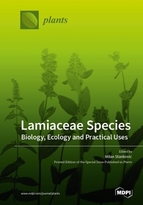Lamiaceae Species: Biology, Ecology and Practical Uses
A special issue of Plants (ISSN 2223-7747).
Deadline for manuscript submissions: closed (15 November 2018) | Viewed by 51305
Special Issue Editor
Interests: plant science; plant biology; plant ecology
Special Issues, Collections and Topics in MDPI journals
Special Issue Information
Dear Colleagues,
Lamiaceae (Labiatae) is an important plant family that consists of 236 genera and more than 7000 species. The largest genera that belong to this family are Salvia, Scutellaria, Stachys, Plectranthus, Hyptis, Teucrium, Vitex, Thymus, Nepeta, etc. The species from the family Lamiaceae inhabit different ecosystems and have a great diversity with a cosmopolitan distribution. Most of the species are aromatic and possess a complex mixture of bioactive compounds that contribute to overall biological activity in both in vitro and in vivo conditions. Secondary metabolites with potent antioxidant, anti-inflammatory, antimicrobial, antiviral, and anticancer effects are crucial in terms of the previously-mentioned biological activities. Moreover, plants that belong to this family are valuable in food, cosmetic, flavoring, fragrance, perfumery, pesticide, and pharmaceutical industries. Because of a wide range of applications, the plants of the family Lamiaceae are widely cultivated and are, therefore, regarded as an indispensable source of functional food. This Special Issue of Plants will contribute to the knowledge of plants that belong to the family Lamiaceae from several aspects, such as morphology and anatomy, diversity and phytogeography, physiology and ecology, methodology of cultivation and collection, uses in traditional and modern folk medicine, diversity, methods for quantitative and qualitative analysis, isolation and purification, methods for chemical modification, as well as in vitro and in vivo biological activities of secondary metabolites.
Dr. Milan S. Stankovic
Guest Editor
Manuscript Submission Information
Manuscripts should be submitted online at www.mdpi.com by registering and logging in to this website. Once you are registered, click here to go to the submission form. Manuscripts can be submitted until the deadline. All submissions that pass pre-check are peer-reviewed. Accepted papers will be published continuously in the journal (as soon as accepted) and will be listed together on the special issue website. Research articles, review articles as well as short communications are invited. For planned papers, a title and short abstract (about 100 words) can be sent to the Editorial Office for announcement on this website.
Submitted manuscripts should not have been published previously, nor be under consideration for publication elsewhere (except conference proceedings papers). All manuscripts are thoroughly refereed through a single-blind peer-review process. A guide for authors and other relevant information for submission of manuscripts is available on the Instructions for Authors page. Plants is an international peer-reviewed open access semimonthly journal published by MDPI.
Please visit the Instructions for Authors page before submitting a manuscript. The Article Processing Charge (APC) for publication in this open access journal is 2700 CHF (Swiss Francs). Submitted papers should be well formatted and use good English. Authors may use MDPI's English editing service prior to publication or during author revisions.
Keywords
- Lamiaceae
- biology
- ecology
- natural products
- ethnobotany
- phytochemistry







